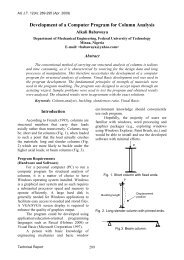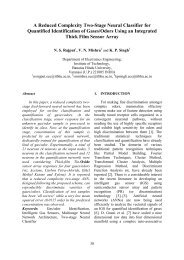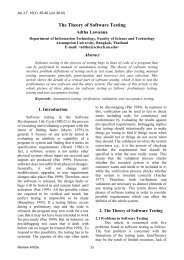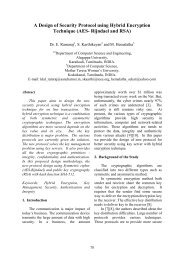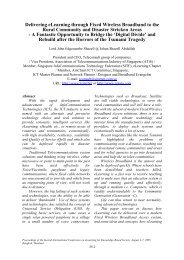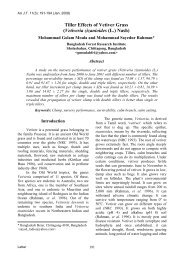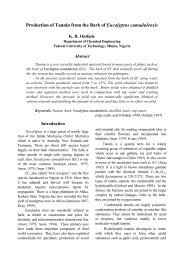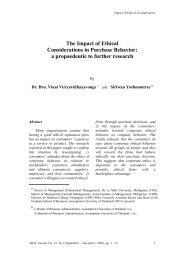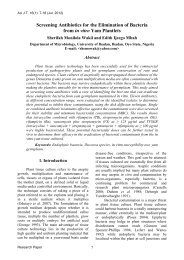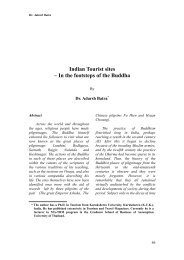(Curd Coconut): Its Mystery and Potentialities - AU Journal
(Curd Coconut): Its Mystery and Potentialities - AU Journal
(Curd Coconut): Its Mystery and Potentialities - AU Journal
Create successful ePaper yourself
Turn your PDF publications into a flip-book with our unique Google optimized e-Paper software.
<strong>AU</strong> J.T. 16(3): 153-158 (Jan. 2013)<br />
<strong>Curd</strong> <strong>Coconut</strong>: <strong>Its</strong> <strong>Mystery</strong> <strong>and</strong> <strong>Potentialities</strong><br />
Narong Chomchalow<br />
Chairman, Thail<strong>and</strong> Network for the Conservation <strong>and</strong> Enhancement of<br />
L<strong>and</strong>races of Cultivated Plants (TNCEL)<br />
E-mail: <br />
Abstract<br />
<strong>Curd</strong> coconut (CC) is a rare abnormality in the meat of the coconut which is<br />
thicker than normal <strong>and</strong> is fluffy <strong>and</strong> soft like curd. Being more delicious than normal<br />
coconut, CC is favored by people who eat it as desert. In ten countries where CC<br />
occurs, its occurrence is at a very low frequency of about 0.15%. CC is produced on a<br />
normal-looking palm which bears mostly normal fruits except for a very few CC fruits.<br />
Such fruit does not germinate, thus cannot be used to propagate the character. The<br />
experienced growers germinate normal-looking fruits obtained from the CC-bearing<br />
palm, which may or may not yield CC fruits after 8 years of planting. A controlled selfpollination<br />
of the CC-bearing palm yield a 3:1 ratio of normal : CC fruits, indicating<br />
that the mother palm is a heterozygote (Kk) for the CC character, which is recessive<br />
(kk). The CC endosperm (kkk) cannot produce the enzyme galacto-mannanase to digest<br />
galactomannan to produce mannan. Thus, it contains galacto-mannan that is viscous,<br />
but is not digested as food of the CC embryo. Consequently, it eventually dies.<br />
Galactomannan is responsible for the fluffy texture of the CC. CC embryo can be<br />
cultured in aseptic condition. Upon growing this cultured embryo to fruit-bearing stage,<br />
CC fruits are produced 100% if self pollinated. A hybridization scheme has been<br />
conducted by the Thail<strong>and</strong> Horticultural Research Institute. Pollen sources were from<br />
embryo-cultured palms while maternal parents were four dwarf cultivars, namely ‘Nam<br />
Hom’, ‘Thung Khlet’, ‘Malayan Yellow Dwarf’, <strong>and</strong> ‘Malayan Red Dwarf’. The F 1<br />
hybrids were mostly semi-dwarf in stature (that is selfing in nature); they all produced<br />
25% CC fruits as expected. The most interesting cross was that with ‘Nam Hom’, in<br />
which 56% have aromatic water. It is postulated that if a backcross is made between<br />
semi-dwarf F 1 with the CC homozygous (kk) embryo-cultured palms, the resultant<br />
offspring would yield 50% CC fruits which doubled that of the F 2 which yields only 25%<br />
CC fruits. Not only CC fruits are delicious, they are also nutritious with higher amount<br />
of saturated <strong>and</strong> less unsaturated fatty acids than normal fruits. CC is always high on<br />
dem<strong>and</strong> because people love to eat CC as desert, even at the price ten times as much as<br />
ordinary coconut. CC growers earn 2.5 times as much compared to ordinary palms if<br />
they grow F 1 hybrids, but will double that amount if they make backcross by using<br />
pollens from homozygous embryo-cultured palms (kk).<br />
Keywords: Galactomannan, heterozygote, embryo-cultured palms, dwarf<br />
cultivars, backcross.<br />
1. Introduction<br />
<strong>Curd</strong> coconut (CC) is a rare abnormality<br />
in the meat of the coconut which is thicker than<br />
normal <strong>and</strong> is fluffy <strong>and</strong> soft like curd. Being<br />
more delicious than normal coconut, it is<br />
favored by people who eat it as desert. It is<br />
found in ten countries among more than 90<br />
coconut-growing countries, namely Cambodia<br />
(called Dong Kathi), India (Thairu Tengai),<br />
Indonesia (Korpyor), Malaysia (Korpyor),<br />
Papua New Guinea (Niu Garuk), Philippines<br />
(Makapuno), Polynesia (Pia), Sri Lanka (Dikiri<br />
Pol), Thail<strong>and</strong> (Maphrao Kathi), <strong>and</strong> Vietnam<br />
(Dua Sap) (Chomchalow 2006).<br />
Review Article 153
<strong>AU</strong> J.T. 16(3): 153-158 (Jan. 2013)<br />
It occurs sporadically in the coconut<br />
grove at a low frequency of 0.15%. The grower<br />
knows exactly which palm would produce CC<br />
fruit <strong>and</strong> can pick the fruit from that particular<br />
palm with no mistake.<br />
2. The <strong>Mystery</strong><br />
In the countries that CC occurs, its<br />
occurrence is at a very low frequency of about<br />
0.15%. It is produced on a normal-looking<br />
palm, known as ‘occasional’ CC-bearing palm,<br />
which bears mostly normal fruits except for a<br />
very few CC fruits. Since CC fruit does not<br />
germinate, it cannot be used to propagate the<br />
character. In order to propagate the CC-bearing<br />
palm, the experienced growers germinate<br />
normal-looking fruits obtained from the<br />
‘occasional’ CC-bearing palm, which may or<br />
may not yield CC fruits after 8 years of<br />
planting (Chomchalow 1987).<br />
2.1 Unusual Mode of Inheritance<br />
CC is naturally borne on a normalappearing<br />
tall coconut palm where only a few<br />
fruits are CC while the majority is normal fruit.<br />
As the CC fruits do not germinate, propagation<br />
is traditionally done by germinating normal<br />
fruits from the CC-yielding palm, which may<br />
or may not yield CC fruits after eight years of<br />
planting.<br />
2.2 Is CC a Variety of the <strong>Coconut</strong>?<br />
There are two schools of thought:<br />
2.2.1 CC is not a variety of the coconut:<br />
This is evident from:<br />
CC fruit is borne on the same bunch<br />
with normal coconut.<br />
It occurs at low frequency <strong>and</strong> does not<br />
occur in every fruit of the same tree.<br />
It does not germinate, thus cannot<br />
reproduce itself.<br />
No true-breeding individual exists.<br />
Some think that it is caused by a disease,<br />
but its causal organism is unknown. Perhaps it<br />
is caused by a virus or a mycoplasma. Some<br />
think that it is caused by a mineral deficiency,<br />
or by exposing to abnormal environment. But<br />
none has a definite evidence to prove its<br />
hypothesis.<br />
2.2.2 CC is a variety of the coconut: This<br />
is evident from:<br />
When a normal fruit from an CC fruitbearing<br />
palm is planted, it sometimes<br />
yields CC fruits.<br />
2.3 <strong>Its</strong> Origin Was a <strong>Mystery</strong><br />
Although the farmers know how to<br />
propagate CC, but no one could explain its<br />
origin. It was believed that CC is borne on the<br />
eastern side of the palm, while others maintain<br />
that it is borne on the western side. Both are<br />
sometimes correct.<br />
3. Types of CC<br />
Based on the thickness <strong>and</strong> softness of<br />
the meat, <strong>and</strong> the amount <strong>and</strong> viscosity of the<br />
water in the fruit cavity, CC can be arbitrarily<br />
classified into the following categories:<br />
Khao Chao CC (non-glutinous): Meat<br />
thickens a little with a little softness having a<br />
little viscous water.<br />
Khao Niao CC (glutinous): Maximum<br />
thickness <strong>and</strong> softness of meat, <strong>and</strong> maximum<br />
water viscosity.<br />
There are, however, a graded series of<br />
meat thickness <strong>and</strong> softness, <strong>and</strong> the amount<br />
<strong>and</strong> viscosity of the water (Figs. 1 <strong>and</strong> 2).<br />
Three factors are involved in the formation of<br />
fluffy meat <strong>and</strong> viscosity of the water. These<br />
are:<br />
The Age of the Fruit at Harvest:<br />
‣ If the fruit is harvest prematurely, the<br />
meat is still not fully developed into<br />
fluffy meat, while there is still a lot of<br />
not-so-much viscous water in the fruit<br />
cavity. This type is the so-called,<br />
“Khao Chao”.<br />
‣ If the fruits is harvested at a proper<br />
age, the meat tend to develop in full<br />
fluffy stage while only a little amount<br />
of viscous water remains in the fruit<br />
cavity. This is the so-called, “Khao<br />
Niao”.<br />
Review Article 154
<strong>AU</strong> J.T. 16(3): 153-158 (Jan. 2013)<br />
‣ If the palm is grown in an optimum<br />
condition, the meat becomes fully<br />
fluffy. It is of the type of “Khao<br />
Niao”.<br />
4. The Hypothesis on the Origin of CC<br />
4.1 The Observation<br />
Fig. 1. Three types of curd coconut varying in<br />
thickness of curd.<br />
CC occurs in a particular coconut palm,<br />
<strong>and</strong> only in some fruits. <strong>Its</strong> cause is considered<br />
by some to be disease, but no causal organism<br />
found.<br />
4.2 The Experiment <strong>and</strong> Conclusion<br />
Controlled self-pollination of an CCproducing<br />
palm yields a 3:1 ratio of normal :<br />
CC progeny (Zuniga 1953). Thus it is<br />
concluded that CC character is controlled by a<br />
single gene in which CC is recessive - k, <strong>and</strong><br />
normal character is dominant - K.<br />
As the CC fruit (kk) cannot germinate, all<br />
CC-bearing palms are heterozygote (Kk).<br />
Fig. 2. Maximum curd layer of curd coconut.<br />
The Storage Period after Harvest:<br />
‣ For prematurely-harvested fruit:<br />
If the fruit is kept for a short<br />
period of time, it still maintains<br />
the status of “Khao Chao”.<br />
If the fruit is kept for a long<br />
period of time, it becomes “Khao<br />
Niao”.<br />
‣ For fruit harvested at proper time:<br />
If the fruit is kept for a short<br />
period of time, it is in the status of<br />
“Khao Niao”.<br />
If the fruit is kept for a long<br />
period of time, all the fluffy meat<br />
disintegrates; this stage is called<br />
“Duean Kin” (moon eats).<br />
The Growing Condition:<br />
‣ If the palm is grown in rather poor<br />
condition, the meat becomes less<br />
fluffy. It is of the type of “Khao<br />
Chao”.<br />
5. Physiological Basis of CC<br />
5.1 Why the Meat of CC is Fluffy?<br />
CC nuts have different cell wall materials<br />
<strong>and</strong> the component sugars of each fraction of<br />
the hydrolysis product varies between CC <strong>and</strong><br />
normal nuts. Having three recessive genes<br />
(kkk), the CC endosperm may well be a case of<br />
cell dedifferentiation occurring on the plant<br />
itself (Kovoor 1981). Through cytochemical<br />
studies, Sebastian et al. (1987) was able to<br />
confirm that there were cellular cytochemical<br />
differences between the endosperm of normal<br />
<strong>and</strong> CC nuts. Such differences support the<br />
abnormal <strong>and</strong> tumour-like character of the CC<br />
cells. In addition, they were of opinion that an<br />
increasing concentration gradient of oil<br />
globules <strong>and</strong> protein bodies towards the testa<br />
suggests the early synthesis of these organelles<br />
during endosperm development.<br />
Review Article 155
<strong>AU</strong> J.T. 16(3): 153-158 (Jan. 2013)<br />
5.2 Why the CC Fruit Cannot Germinate?<br />
Chomchalow (2006) postulated that CC<br />
endosperm (kkk) cannot produce the enzyme<br />
galactomannanase to digest galactomannan to<br />
produce mannan. Thus, it contains<br />
galactomannan which is viscous, but is not a<br />
food of the CC embryo. Consequently, it dies<br />
eventually. Galactomannan is responsible for<br />
the fluffy texture of CC.<br />
6. Exploitation of the Knowledge<br />
6.1 Embryo Culture to Obtain Homozygous<br />
Line of CC<br />
CC embryo can be cultured in aseptic<br />
condition until the plantlet is big enough to be<br />
transplanted in the nursery. Upon growing this<br />
cultured embryo to fruit bearing stage, <strong>and</strong><br />
upon self-pollination, CC fruits are produced<br />
100% (de Guzman 1969).<br />
Such a scheme has been adopted by the<br />
Uti Palmoil Seeds Co. Ltd., who grew 10,000<br />
CC-embryo-cultured palms obtained from the<br />
farmers throughout the country on an isolated<br />
isl<strong>and</strong> in Vajiralongkorn Reservoir, Thong Pha<br />
Phum District, Kanchanaburi Province. About<br />
2000 CC palms survived <strong>and</strong> all produced<br />
100%CC fruits as expected.<br />
6.2 Hybridization to Obtain Dwarf F 1 Palms<br />
for Commercial Production of CC<br />
A hybridization scheme has been<br />
conducted by the Thail<strong>and</strong> Horticultural<br />
Research Institute (HRI). Pollen sources are<br />
from embryo-cultured CC palms while<br />
maternal parents are four dwarf cultivars,<br />
namely ‘Nam Hom’, ‘Thung Khlet’, ‘Malayan<br />
Yellow Dwarf’, <strong>and</strong> ‘Malayan Red Dwarf’.<br />
The F 1 hybrids are mostly semi-dwarf (which<br />
is self-pollinated in nature). They all produce<br />
25% CC fruits as expected. The most<br />
interesting cross is that with ‘Nam Hom’ in<br />
which 56% have aromatic water (Fig. 3)<br />
(Wattanayothin 2005).<br />
Fig. 3. ‘Aromatic’ x curd coconut hybrid<br />
‘Prolific bearing’ curd coconut.<br />
Review Article 156
<strong>AU</strong> J.T. 16(3): 153-158 (Jan. 2013)<br />
6.3 Backcrossing F 1 with Homozygous Line<br />
to Double the Amount of CC<br />
Chomchalow (2006) postulated that if a<br />
backcross is made between the semi-dwarf F 1<br />
with the CC homozygous embryo-cultured<br />
palms, the resultant offspring would yield 50%<br />
CC fruits which doubled that of the F 2 which<br />
yields only 25% CC fruits.<br />
6.4 Natural Pollination of Dwarf Maternal<br />
Parents by Homozygous CC Palms<br />
Since production of F 1 hybrids (in # 6.2)<br />
is labor intensive, requiring emasculation of the<br />
maternal parents as well as pollination with<br />
pollens obtained from collecting CC pollens by<br />
climbing the tall palms, Charanasri (personal<br />
communication, 2013) is of opinion that it<br />
would be more convenient <strong>and</strong> obtaining better<br />
result if selected dwarf palms were interplanted<br />
in the CC grove on the isolated isl<strong>and</strong>. When<br />
the dwarf palms start to produce inflorescences,<br />
every one would be emasculated prior to pollen<br />
dehiscence in order to prevent them from<br />
pollinating the whole of CC plants on the<br />
isl<strong>and</strong>. Through natural pollination, the dwarf<br />
palms would be pollinated by pollens of CC<br />
palms resulting in production of F 1 hybrids<br />
with much less effort in pollination. In this<br />
way, large amount of F 1 hybrid seedlings could<br />
be produced for commercial planting, which is<br />
on high dem<strong>and</strong> at present.<br />
7. Benefits of CC<br />
7.1 Nutritional Value of CC<br />
Not only CC fruits are delicious, they are<br />
also nutritious. Upon chemical analysis, CC<br />
has 93.3% saturated fatty acids (SFA)<br />
compared to normal palms of about 90%<br />
(Chomchalow 2006). It is now well known that<br />
SFA is health promotion, contradicting to the<br />
earlier belief that they cause heart disease<br />
(Wickremasinghe 1994). It has also less<br />
unsaturated fatty acid, both mono (5.5%), <strong>and</strong><br />
poly (0.8%), in contrast to normal palms which<br />
have about 10.3% mono- <strong>and</strong> 2.3%<br />
polyunsaturated fatty acids (Chomchalow<br />
2006). It is now known that unsaturated fatty<br />
acids are hazardous to health, in contrast to<br />
earlier belief.<br />
7.2 Dem<strong>and</strong> for CC<br />
CC is always high on dem<strong>and</strong> because<br />
people love to eat CC as desert, even at the<br />
price ten times as much as ordinary coconut.<br />
CC can also be industrially processed into<br />
various food products including ice cream, pie,<br />
bottled or canned desert (Chomchalow 2006).<br />
7.3 Benefits to the Growers<br />
Assuming that a coconut palm yield 100<br />
fruits per year (in reality, it is higher), a grower<br />
who grows F 1 hybrid dwarf palms will obtain,<br />
through self-pollination, 75 normal fruits <strong>and</strong><br />
25 CC fruits (a 3:1 ratio). Based on the<br />
assumption that CC fruit fetches ten times as<br />
much as the ordinary fruit (Chomchalow<br />
2006), CC grower earns (1 × 75) + (10 × 25) =<br />
325 units of money, while ordinary coconut<br />
grower earns (1 × 100) = 100 units of money (a<br />
unit is to the price per coconut fruit). Thus CC<br />
grower earns 325 - 100 = 225 units or 2.25<br />
times more if they grow F 1 hybrids. But the<br />
income will double if he makes backcross of<br />
the F 1 hybrid by using pollens from<br />
homozygous embryo-cultured CC palms to<br />
obtain a 1:1 ratio in the progeny, instead of a<br />
3:1 ratio. By simple calculation, the income of<br />
CC grower would be (10 × 50) + (1 × 50) =<br />
550 units of money. This is 550 - 100 = 450<br />
units or 4.5 times more than that of ordinary<br />
coconut grower (of 100 units). Adding the fact<br />
that a hybrid normally yields 20% higher than<br />
the purebred, the income would be 540 units or<br />
5.4 times higher.<br />
8. Epilogue<br />
The Thai Department of Agriculture is<br />
now able to produce 1,000 nuts per month of<br />
the F 1 hybrids of the four crosses mentioned<br />
earlier (in # 6.2) for sale to the farmers on a<br />
first-come-first serve basis at a very cheap<br />
price of Baht 30 (about 1 US $) per seedlings.<br />
Within three years time, all these seedlings<br />
would bear fruits, one fourth of which will give<br />
CC nuts. Of the remaining three-fourths normal<br />
Review Article 157
<strong>AU</strong> J.T. 16(3): 153-158 (Jan. 2013)<br />
looking nuts, two parts are heterozygotes, <strong>and</strong><br />
can be used as planting materials for the next<br />
generation. This is a special case of hybrids<br />
producing true to type hybrids for planting.<br />
By the time these first lot of CC hybrid<br />
start to produce fruit, large amount of embryocultured<br />
palms would be grown. These would<br />
provide a good source of pollens to pollinate<br />
the F 1 palms so that the progeny is expected to<br />
give a backcross ratio of 1 : 1, instead of an F 2<br />
ratio of 3 : 1. In such a case, half of the nuts is<br />
CC while the other half is heterozygous which<br />
can be used as planting material for the next<br />
generation. This has one distinct advantage; the<br />
farmer does not have to take one of three<br />
chances of planting a normal coconut, as all the<br />
normal-appearing nuts are heterozygotes!<br />
As Thail<strong>and</strong> is the only country in the<br />
world that has ‘Nam Hom’ cultivar, the<br />
aromatic water - CC fruit is certainly a bonus in<br />
the CC palm production since it adds aroma to<br />
the already delicious fluffy meat.<br />
It is hoped that within ten years, Thail<strong>and</strong><br />
would become the world largest producer <strong>and</strong><br />
exporter of CC coconut.<br />
9. References<br />
Charanasri, U. 2013. Personal Communication.<br />
Chomchalow, N. 1987. Maphrao Kathi<br />
(makapuno). Chaiyaphruek Witthayasat.<br />
202: 6-9 (in Thai).<br />
Chomchalow, N. 2006. Maphroa Kathi.<br />
Thail<strong>and</strong> Network for the Conservation <strong>and</strong><br />
Enhancement of L<strong>and</strong>races of Cultivated<br />
Plants (TNCEL), Bangkok, Thail<strong>and</strong> (in<br />
Thai).<br />
de Guzman, E.V. 1969. The growth <strong>and</strong><br />
development of coconut ‘makapuno’<br />
embryo in vitro. 1. The induction of rooting.<br />
Philippine Agriculturist 53(2): 65-78.<br />
Kovoor, A. 1981. Palm tissue culture: state of<br />
the art <strong>and</strong> its application to the coconut.<br />
Technical Working Party on <strong>Coconut</strong><br />
Production, Protection <strong>and</strong> Processing,<br />
Session 5, Manila, The Philippines, 3<br />
December 1979. FAO Plant Production <strong>and</strong><br />
Protection Paper No. 30. Plant Production<br />
<strong>and</strong> Protection Division, Food <strong>and</strong><br />
Agriculture Organization (FAO) of the<br />
United Nations (UN), Rome, Italy.<br />
Sebastian, L.C.; Mujer, C.U.; <strong>and</strong> Mendoza,<br />
E.M.T. 1987. A comparative cytochemical<br />
study on mature makapuno <strong>and</strong> normal<br />
coconut endosperm. Philippine <strong>Journal</strong> of<br />
<strong>Coconut</strong> Studies 12(1): 14-22.<br />
Watanayothin, S. 2005. The study on curd<br />
coconut hybrids. <strong>Journal</strong> of TNCEL 1(3): 6-<br />
7 (in Thai).<br />
Wickremasinghe, R.L. 1994. <strong>Coconut</strong> oil, not<br />
the villain. Cocoinfo International 1(2): 6-7.<br />
Zuniga, L.C. 1953. The probable inheritance of<br />
the makapuno character of the coconut.<br />
Philippine Agriculturist 36: 402-13.<br />
Review Article 158



